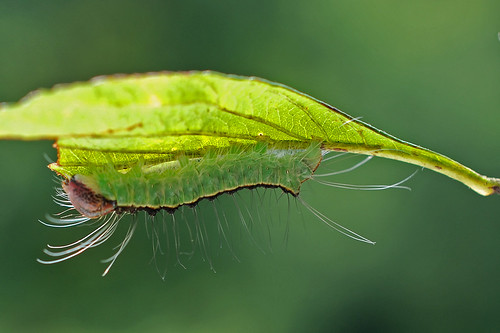
A guest post by Scott Maxham
Last week I was out clearing Japanese knotweed from the riverside. Clearing knotweed can be a daunting task. It takes over large areas and deprives other plants of sunlight. While taking a much needed water break, a few feet away from the knotweed patch, I found a spiky surprise. This black red spotted caterpillar looked a bit menacing with the numerous spikes, but I was feeling adventurous and let him crawl into my hands. This caterpillar seemed ginormous after working with the tiny cecropia caterpillars we have been raising at the Nature Center.
Back at the Center Center Chip and I determined that I found a Mourning Cloak Caterpillar. Chip agreed that it was a big caterpillar and would probably be looking to pupate in the near future. Sure enough the next day we found the mourning cloak hanging upside down from the container it now calls home. If you’re interested you can see the mourning cloak pupae here at the Nature Center in our critter room.
The mourning cloak butterfly is one of the first to be seen in the spring. This is because it overwinters as an adult butterfly and does not migrate. They find safe spots in trees or logs to overwinter. The butterfly hibernates and when spring arrives the mourning cloak is ready to find a mate. The mourning cloak is unique in that it remains an adult butterfly for 10 long months. This is much longer than most butterflies live. Most butterflies will live for about a month. Even the migrating monarch butterfly will live a shorter life, usually around 7 to 8 months.
 |
| Photo by Jo Ann Poe-McGavin |
Yesterday Ken was out and about with the “Incredible Insects” summer camp. While they were out looking for bugs, they found a caterpillar that I consider incredible, but prefers to be called “splendid”. Ken and the kids brought back a pair of splendid dagger moth caterpillars! These caterpillars have a bit of fuzz surrounding them and change from green to brown when they are about to molt. They grow up to be stealthy moths that blend in with tree bark.
All these caterpillars have been a warm-up for the rapidly approaching Live Caterpillar Day at NBNC. This Saturday, July 26, between 11am and 4pm Sam Jaffe from the Caterpillar Lab will be coming to the Nature Center to show off his wonderful caterpillars. If you can’t make it to caterpillar day or can’t wait until Saturday to see caterpillars you can again stop by the critter room at NBNC. The cecropia caterpillars are plentiful and have grown to be much more colorful. Hope to see you Saturday at Caterpillar Day!



No comments:
Post a Comment